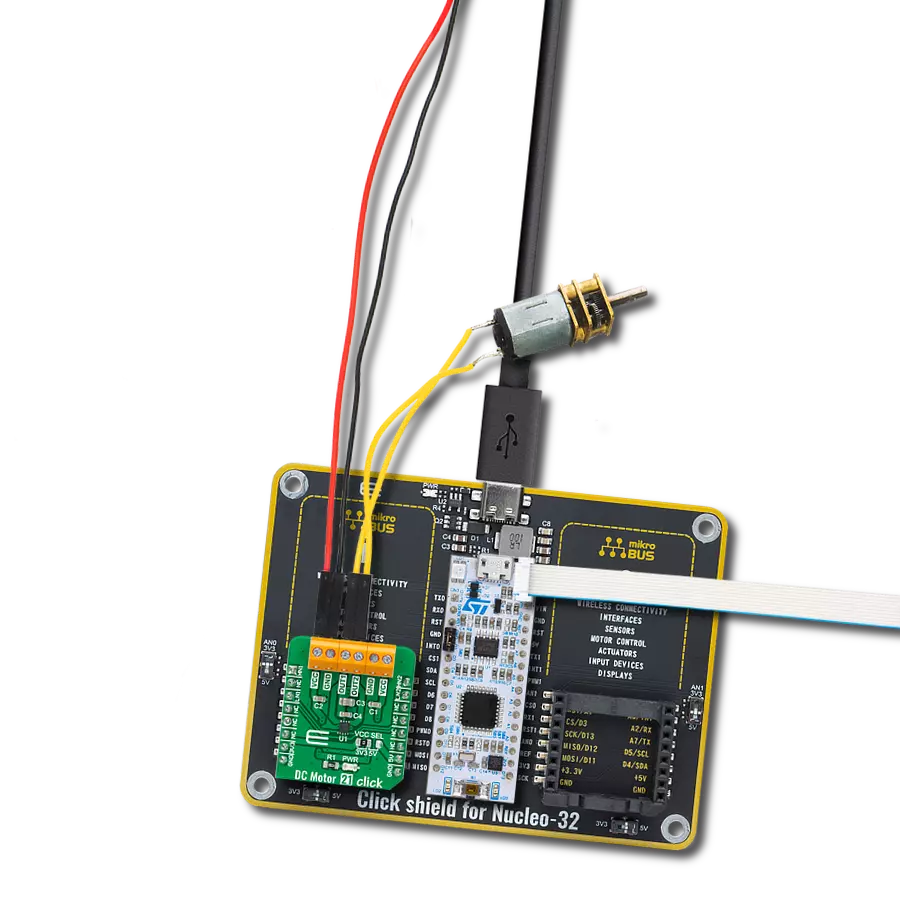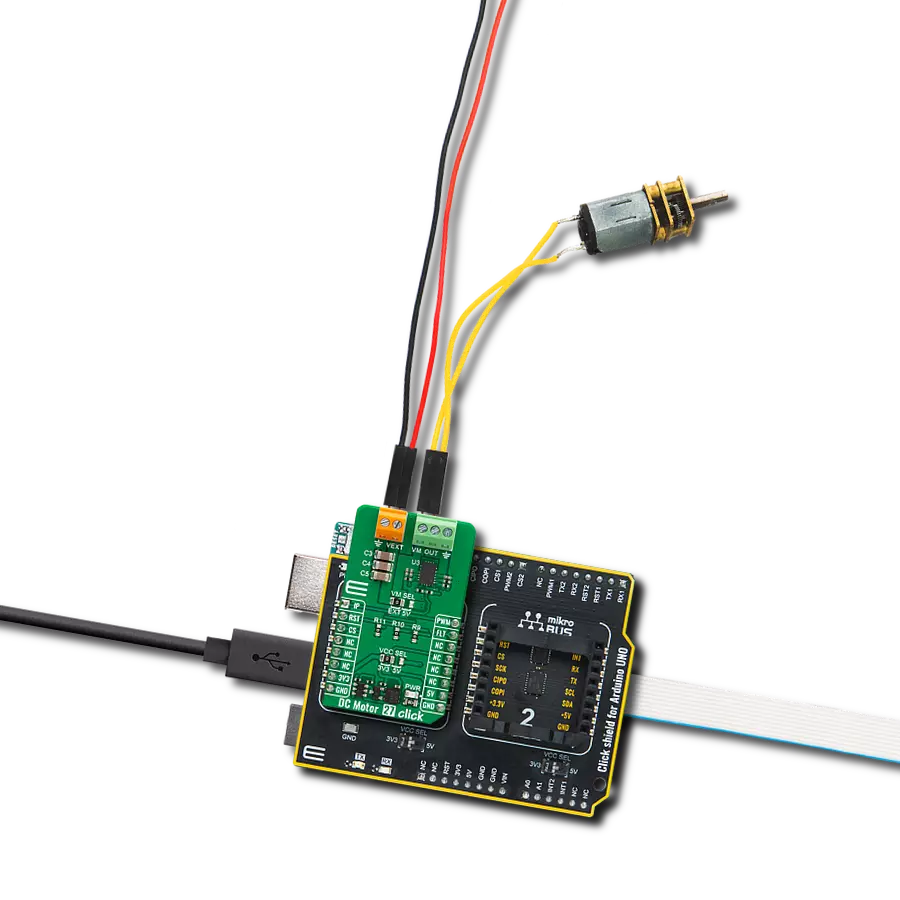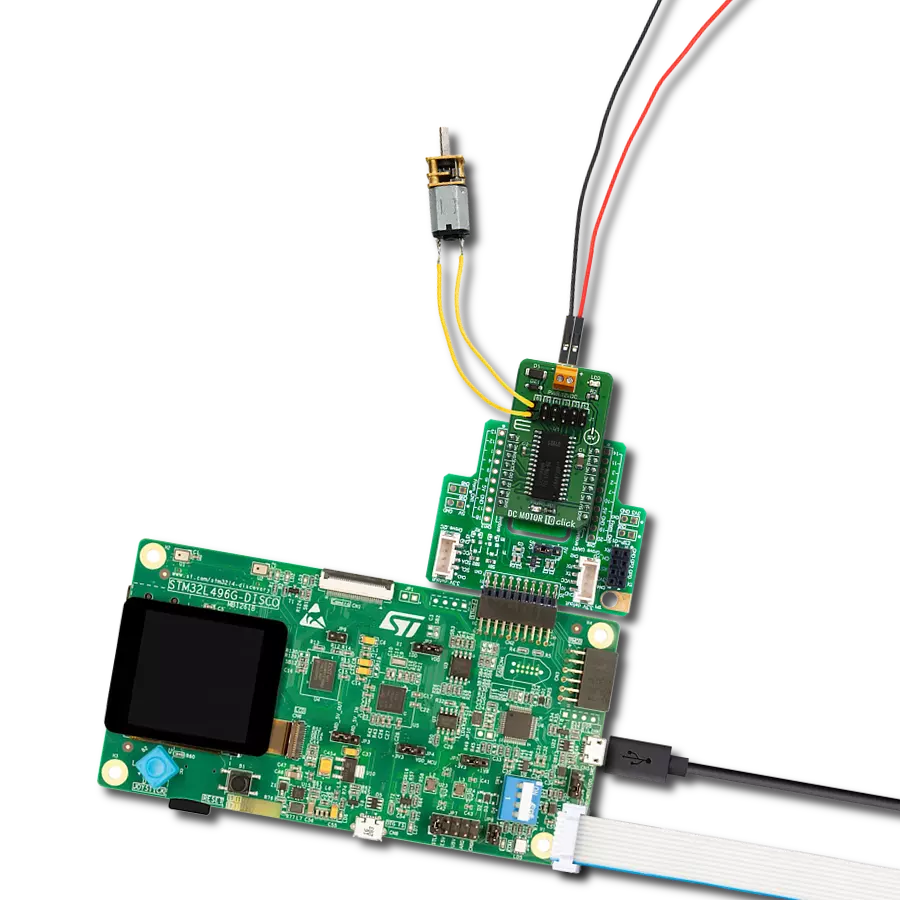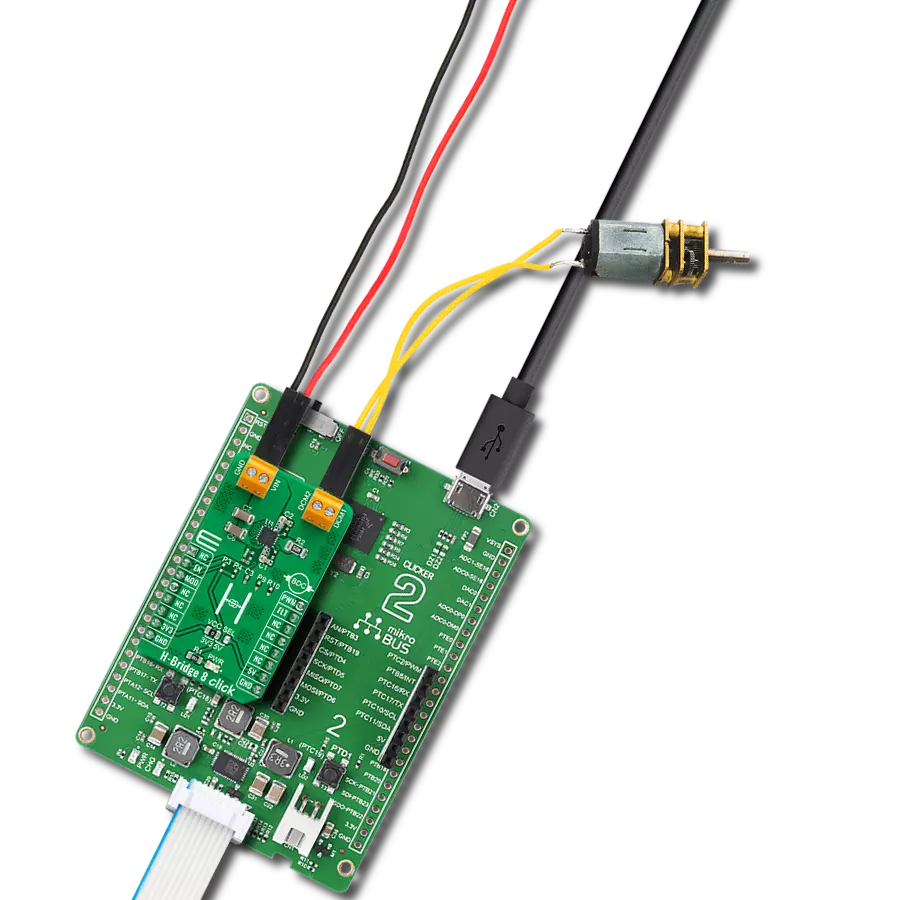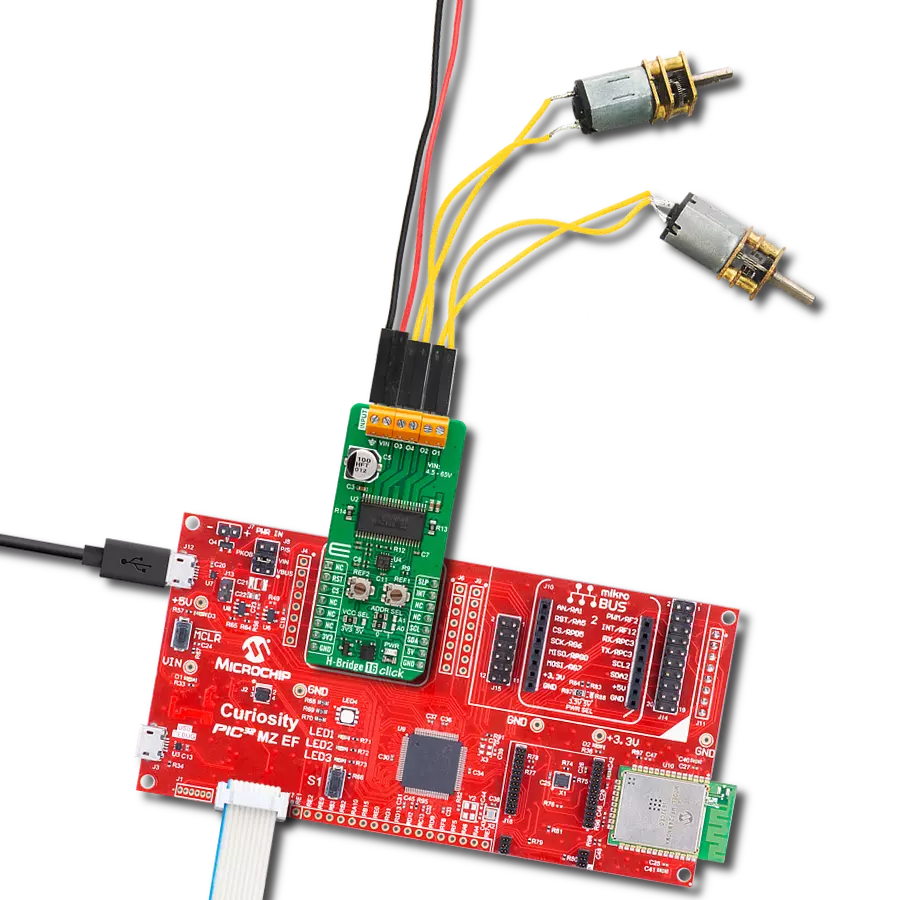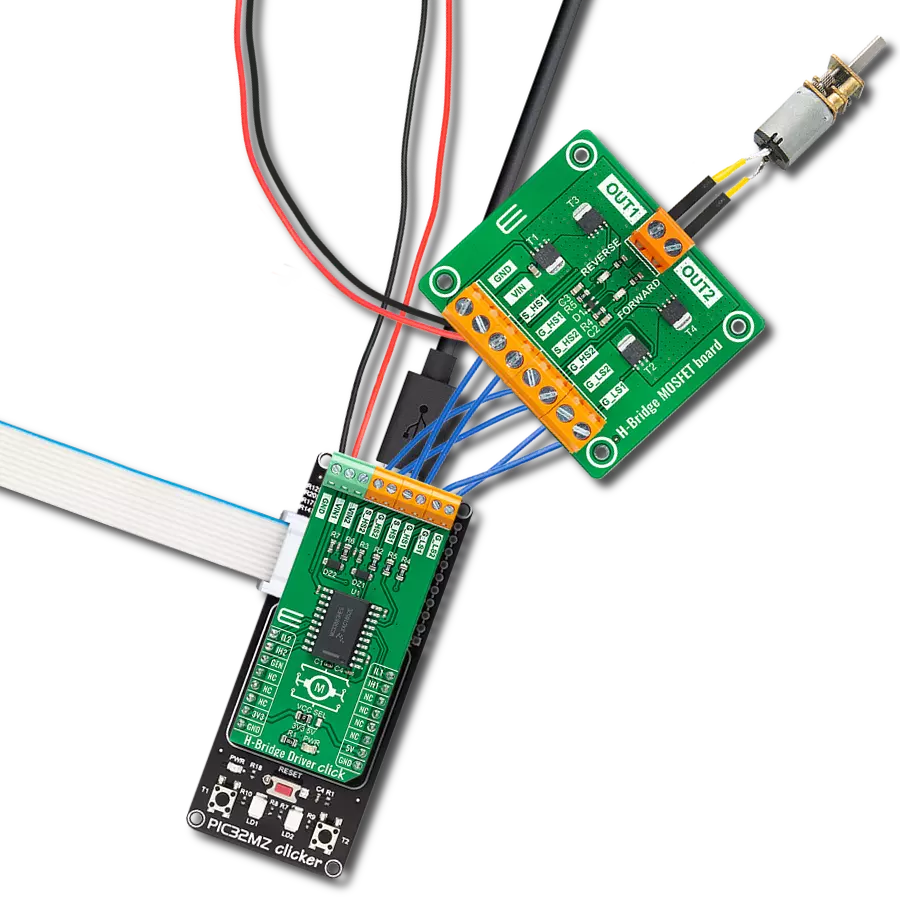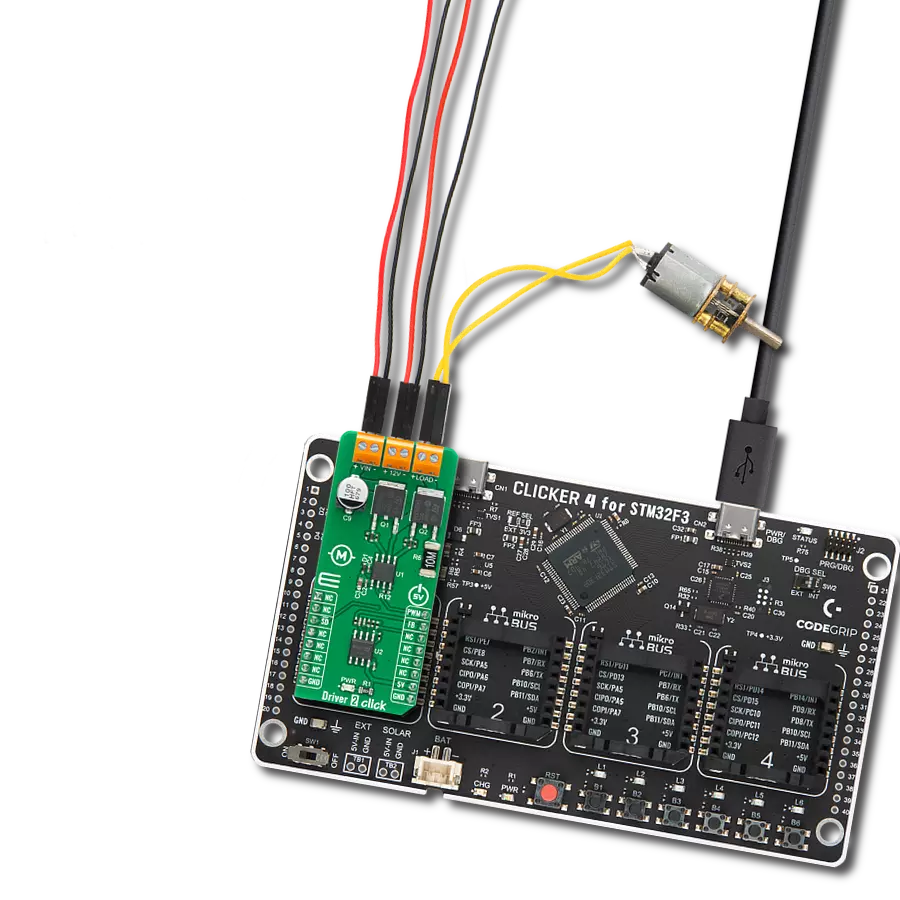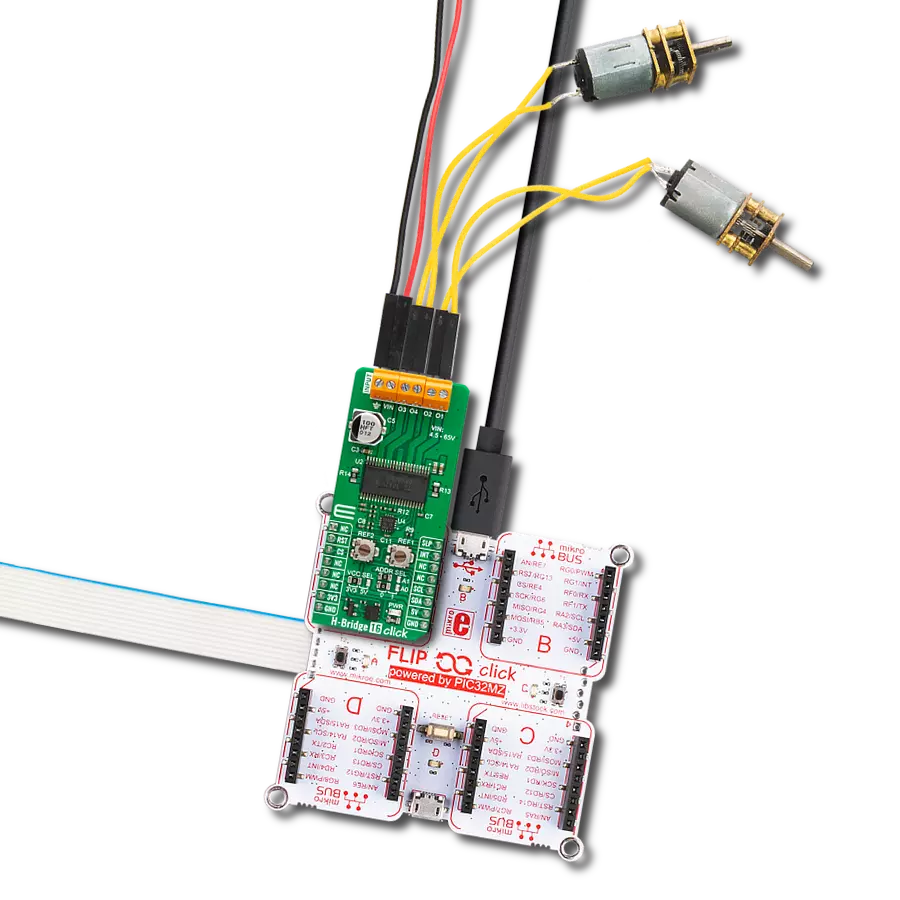Drive DC motors and actuators with configurable current limits and robust safety features
A
A
Hardware Overview
How does it work?
H-Bridge 17 Click is based on the MP6619L, an H-bridge motor driver IC from MPS designed for driving brushed DC motors, solenoids, and actuators. The MP6619L operates from an external supply voltage ranging between 2.5V and 28V via the VIN terminal and delivers high motor currents, ensuring reliable performance even under demanding conditions. This Click board™ is ideal for applications requiring precise motor control and robust safety mechanisms, offering reliable performance in industrial, automotive, and consumer settings. This Click board™ provides flexible control through several pins on the mikroBUS™ socket. The IN1 and IN2 pins control the output channels (OUT1 and OUT2), while the
EN pin turns the motor driver IC ON or OFF. For added customization, the MP6619L features a configurable current limit that can be set using the ISET SEL jumper. This jumper allows users to select between three current limit values: 1A, 2A, or 4A. For 1A and 2A, the jumper is placed in the corresponding position, while for 4A, the jumper position must be left open, requiring the removal of a specific resistor. H-Bridge 17 Click also incorporates several safety and diagnostic features. The FLT pin acts as a fault indicator, and it works in combination with a red FLT LED to signal if any protection circuits, such as overcurrent, overtemperature, overvoltage, or undervoltage lockout, are activated. This ensures that users are
immediately informed of fault conditions, enabling quick troubleshooting. Additionally, the overcurrent protection (OCP) can be turned ON or OFF using the OCP SEL jumper, providing further flexibility in configuring the board to suit specific application requirements. This Click board™ can operate with either 3.3V or 5V logic voltage levels selected via the VCC SEL jumper. This way, both 3.3V and 5V capable MCUs can use the communication lines properly. Also, this Click board™ comes equipped with a library containing easy-to-use functions and an example code that can be used as a reference for further development.
Features overview
Development board
6LoWPAN Clicker is a compact starter development board that brings the flexibility of add-on Click boards™ to your favorite microcontroller, making it a perfect starter kit for implementing your ideas. It comes with an onboard 32-bit PIC microcontroller, the PIC32MX470F512H from Microchip, a USB connector, LED indicators, buttons, a mikroProg connector, and a header for interfacing with external electronics. Along with this microcontroller, the board also contains a 2.4GHz ISM band transceiver, allowing you to add wireless communication to your target application. Its compact design provides a fluid and immersive working experience, allowing access anywhere
and under any circumstances. Each part of the 6LoWPAN Clicker development kit contains the components necessary for the most efficient operation of the same board. In addition to the possibility of choosing the 6LoWPAN Clicker programming method, using USB HID mikroBootloader, or through an external mikroProg connector for PIC, dsPIC, or PIC32 programmer, the Clicker board also includes a clean and regulated power supply module for the development kit. The USB Micro-B connection can provide up to 500mA of current for the Clicker board, which is more than enough to operate all onboard and additional modules, or it can power
over two standard AA batteries. All communication methods that mikroBUS™ itself supports are on this board, including the well-established mikroBUS™ socket, reset button, and several buttons and LED indicators. 6LoWPAN Clicker is an integral part of the Mikroe ecosystem, allowing you to create a new application in minutes. Natively supported by Mikroe software tools, it covers many aspects of prototyping thanks to a considerable number of different Click boards™ (over a thousand boards), the number of which is growing every day.
Microcontroller Overview
MCU Card / MCU

Architecture
PIC32
MCU Memory (KB)
512
Silicon Vendor
Microchip
Pin count
64
RAM (Bytes)
131072
You complete me!
Accessories
DC Gear Motor - 430RPM (3-6V) represents an all-in-one combination of a motor and gearbox, where the addition of gear leads to a reduction of motor speed while increasing the torque output. This gear motor has a spur gearbox, making it a highly reliable solution for applications with lower torque and speed requirements. The most critical parameters for gear motors are speed, torque, and efficiency, which are, in this case, 520RPM with no load and 430RPM at maximum efficiency, alongside a current of 60mA and a torque of 50g.cm. Rated for a 3-6V operational voltage range and clockwise/counterclockwise rotation direction, this motor represents an excellent solution for many functions initially performed by brushed DC motors in robotics, medical equipment, electric door locks, and much more.
Used MCU Pins
mikroBUS™ mapper
Take a closer look
Click board™ Schematic

Step by step
Project assembly
Software Support
Library Description
H-Bridge 17 Click demo application is developed using the NECTO Studio, ensuring compatibility with mikroSDK's open-source libraries and tools. Designed for plug-and-play implementation and testing, the demo is fully compatible with all development, starter, and mikromedia boards featuring a mikroBUS™ socket.
Example Description
This example demonstrates the use of the H-Bridge 17 Click board by driving the motor in both directions with braking and freewheeling.
Key functions:
hbridge17_cfg_setup- Config Object Initialization function.hbridge17_init- Initialization function.hbridge17_set_out_state- This function is used to set the output state of the H-Bridge 17 Click board.hbridge17_ic_enable- This function enables driver IC by setting the EN (RST) pin on the high level of the H-Bridge 17 Click board.hbridge17_fault_indication- This function reads the state of the FLT (INT) pin of the H-Bridge 17 Click board.
Application Init
Initializes the driver and enable H-Bridge driver IC.
Application Task
The demo application drives the motor in both directions with coasting and braking in between, every state lasts 5 seconds.
Open Source
Code example
The complete application code and a ready-to-use project are available through the NECTO Studio Package Manager for direct installation in the NECTO Studio. The application code can also be found on the MIKROE GitHub account.
/*!
* @file main.c
* @brief H-Bridge 17 Click Example.
*
* # Description
* This example demonstrates the use of the H-Bridge 17 Click board by
* driving the motor in both directions with braking and freewheeling.
*
* The demo application is composed of two sections :
*
* ## Application Init
* Initializes the driver and enable H-Bridge driver IC.
*
* ## Application Task
* The demo application drives the motor in both directions
* with coasting and braking in between, every state lasts 5 seconds.
*
* @author Nenad Filipovic
*
*/
#include "board.h"
#include "log.h"
#include "hbridge17.h"
static hbridge17_t hbridge17; /**< H-Bridge 17 Click driver object. */
static log_t logger; /**< Logger object. */
void application_init ( void )
{
log_cfg_t log_cfg; /**< Logger config object. */
hbridge17_cfg_t hbridge17_cfg; /**< Click config object. */
/**
* Logger initialization.
* Default baud rate: 115200
* Default log level: LOG_LEVEL_DEBUG
* @note If USB_UART_RX and USB_UART_TX
* are defined as HAL_PIN_NC, you will
* need to define them manually for log to work.
* See @b LOG_MAP_USB_UART macro definition for detailed explanation.
*/
LOG_MAP_USB_UART( log_cfg );
log_init( &logger, &log_cfg );
log_info( &logger, " Application Init " );
// Click initialization.
hbridge17_cfg_setup( &hbridge17_cfg );
HBRIDGE17_MAP_MIKROBUS( hbridge17_cfg, MIKROBUS_1 );
if ( DIGITAL_OUT_UNSUPPORTED_PIN == hbridge17_init( &hbridge17, &hbridge17_cfg ) )
{
log_error( &logger, " Communication init." );
for ( ; ; );
}
hbridge17_ic_enable( &hbridge17 );
log_info( &logger, " Application Task " );
log_printf( &logger, "-------------------\r\n" );
Delay_ms ( 100 );
}
void application_task ( void )
{
if ( HBRIDGE17_OK == hbridge17_set_out_state( &hbridge17, HBRIDGE17_DRIVE_MOTOR_FORWARD ) )
{
log_printf( &logger, " Motor in forward mode.\r\n" );
Delay_ms ( 1000 );
Delay_ms ( 1000 );
Delay_ms ( 1000 );
Delay_ms ( 1000 );
Delay_ms ( 1000 );
}
if ( HBRIDGE17_OK == hbridge17_set_out_state( &hbridge17, HBRIDGE17_DRIVE_MOTOR_BRAKE ) )
{
log_printf( &logger, " Motor brake is on.\r\n" );
Delay_ms ( 1000 );
Delay_ms ( 1000 );
Delay_ms ( 1000 );
Delay_ms ( 1000 );
Delay_ms ( 1000 );
}
if ( HBRIDGE17_OK == hbridge17_set_out_state( &hbridge17, HBRIDGE17_DRIVE_MOTOR_REVERSE ) )
{
log_printf( &logger, "Motor in reverse mode.\r\n" );
Delay_ms ( 1000 );
Delay_ms ( 1000 );
Delay_ms ( 1000 );
Delay_ms ( 1000 );
Delay_ms ( 1000 );
}
if ( HBRIDGE17_OK == hbridge17_set_out_state( &hbridge17, HBRIDGE17_DRIVE_MOTOR_FREEWHEEL ) )
{
log_printf( &logger, " Motor is coasting.\r\n" );
Delay_ms ( 1000 );
Delay_ms ( 1000 );
Delay_ms ( 1000 );
Delay_ms ( 1000 );
Delay_ms ( 1000 );
}
log_printf( &logger, "-------------------\r\n" );
Delay_ms ( 1000 );
}
int main ( void )
{
/* Do not remove this line or clock might not be set correctly. */
#ifdef PREINIT_SUPPORTED
preinit();
#endif
application_init( );
for ( ; ; )
{
application_task( );
}
return 0;
}
// ------------------------------------------------------------------------ END
Additional Support
Resources
Category:Brushed






















